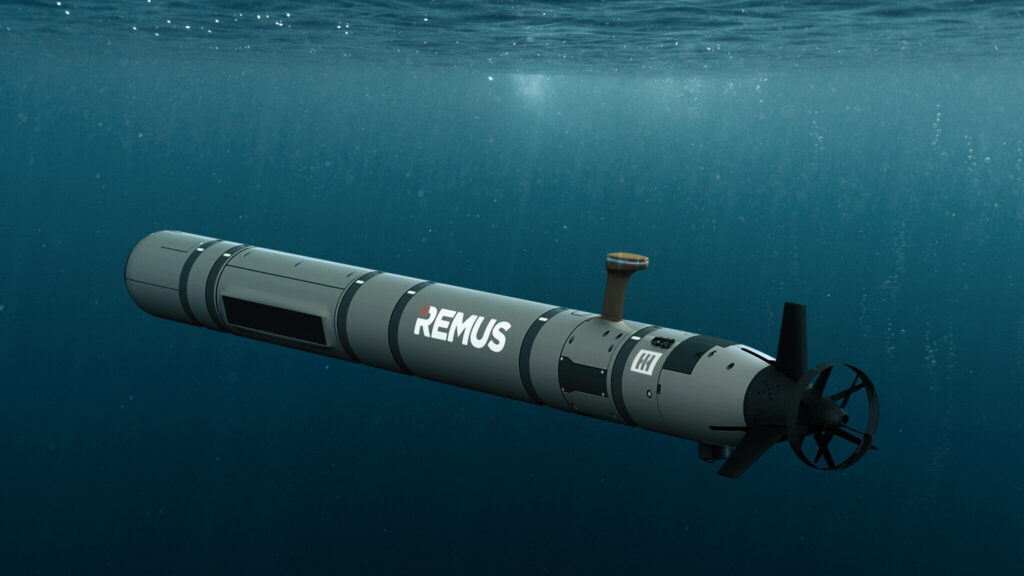
ARLINGTON, Va. — HII’s Mission Technologies division has developed a new generation of medium unmanned underwater vehicle (MUUV) — the REMUS 620 — that leverages advances incorporated in its smaller REMUS 300 UUV, the company said in a Nov. 7 press conference and news release.
The REMUS 620 is based on the design of the REMUS 300, which has been selected by the U.S. Navy as its new Lionfish small UUV. The REMUS 620 will feature longer range and endurance, capable of a battery endurance of up to 110 hours and a range of 275 nautical miles. With a synthetic-aperture sonar installed, the REMUS 620 will have a battery life of 78 hours and a range of 200 nautical miles. The MUUV can sprint up at 8 knots and will have a navigation accuracy of 0.1% of distance travelled, said Duane Fotheringham, president of Mission Technologies’ Unmanned Systems business group.
The 12 ¾-inch-diameter REMUS 620 has the same size and weight as the REMUS 600, of which the company has delivered 175 to customers in the United States, United Kingdom, Australia and Japan. The REMUS 600 is the basis for the U.S. Navy’s MUUVs currently used by mine countermeasures squadrons (Mk18 Mod 2 Kingfish), Naval Oceanographic Office (Littoral Battleship Sensing-Autonomous Undersea Vehicle) and submarine force (LBS-Razorback). The REMUS 620 is designed for such missions as mine countermeasures, hydrographic surveys, intelligence collection, surveillance, cyber warfare and electronic warfare.
The REMUS 620, developed with HII’s internal funding, features modern core electronics and navigation and communications systems and modular, open architecture interfaces to accommodate wet or dry payloads, including towed payloads and custom payloads developed by customers. The UUV includes HII’s Odyssey suite of advanced autonomy solutions for intelligent, robotic platforms, including the Odyssey Mission Management Software.
Mission data can be offloaded from the UUV by a removable hard drive, WiFi and Iridium satellite link, with other options including line-of-sight RF, high-data rate transmission, acoustic modems, optical modems and plug-in ethernet, Fotheringham said.
The REMUS 620 features several interchangeable batteries that can be quickly exchanged for fully charged batteries.
The REMUS 620 can be deployed from submarines, surface combatants, amphibious warfare ships, small manned or unmanned craft and helicopters. The new UUV can also be a platform from which to launch small UUVs or UAVs.
Fotheringham said that the U.S. Navy has said it has launched and recovered REMUS 600 Razorbacks from the dry-deck shelters of submarines and out of torpedo tubes.
“Recently there has been quite a bit in the press about the Navy’s efforts for launch and recovery of UUVs back into the torpedo tubes,” he said. “Those stories indicated the Razorback vehicles are being tested with that capability of recovery back into a torpedo tube.”
He said the capability to recover UUVs back into a torpedo tube is being worked by Woods Hole Oceanographic Institution, where the REMUS technology originally was developed.
“That solution that [Woods Hole] is developing for torpedo tube recovery is also compatible with the REMUS 620,” Fotheringham said.
“Retaining a forward strategic advantage requires the ability to deliver a multitude of effects from under the sea,” Fotheringham said. “The REMUS 620 is the first medium UUV designed to accurately deliver this range of advanced above-and-below water effects at long range.”
“We are prototyping and building the first vehicle now,” Fotheringham said. “We expect the first vehicle to be completed and in the water in 2023 with customer delivery in late ’23 or early ‘24.”
He said HII was in discussions with the U.S. Navy about the REMUS 620 but was not free to offer details.
- Insitu Going Strong at 30, Focusing on Maritime Operations - April 8, 2024
- Navy Awards Boeing Additional Funds for MQ-25 Drones for Testing - April 3, 2024
- Benign 4th Fleet AOR Useful for Unmanned Vehicle Operationalization, Admiral Says - March 27, 2024






